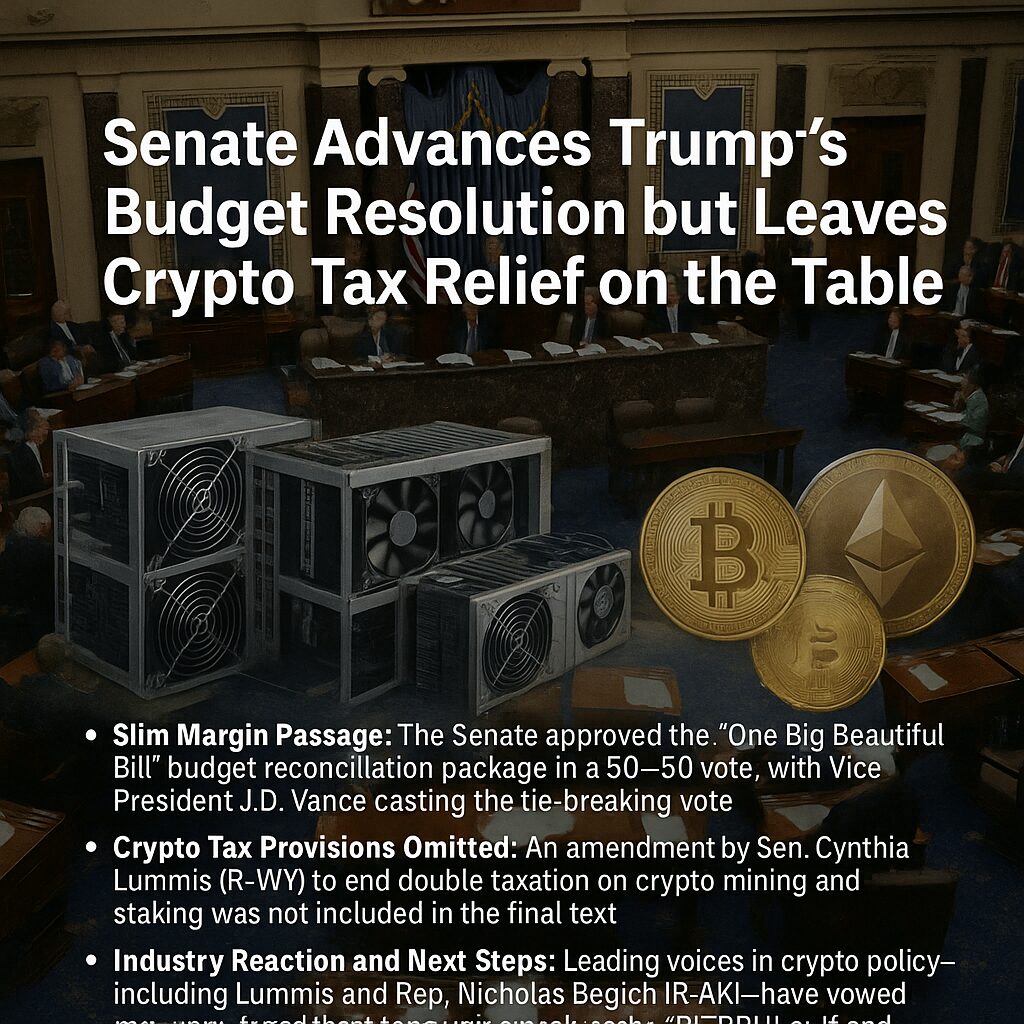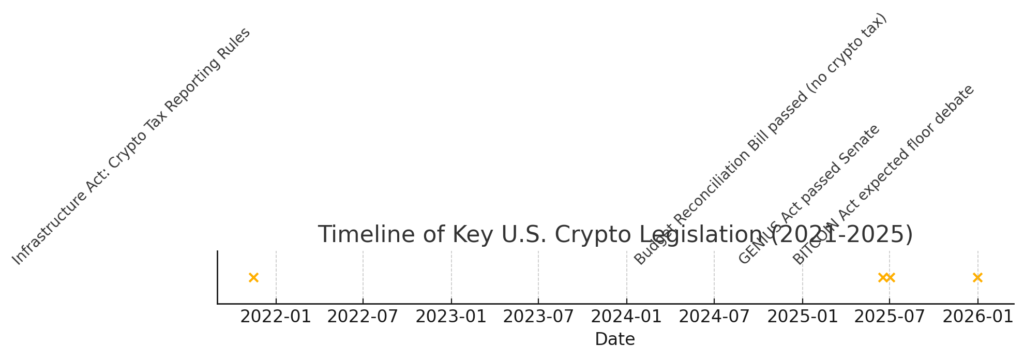
Main Points:
- Slim Margin Passage: The Senate approved the “One Big Beautiful Bill” budget reconciliation package in a 50–50 vote, with Vice President J.D. Vance casting the tie‐breaking vote.
- Crypto Tax Provisions Omitted: An amendment by Sen. Cynthia Lummis (R-WY) to end double taxation on crypto mining and staking was not included in the final text.
- Industry Reaction and Next Steps: Leading voices in crypto policy—including Lummis and Rep. Nicholas Begich (R-AK)—have vowed to pursue standalone legislation such as the “BITCOIN Act” and continue pushing tax reforms in future must-pass bills.
- Broader Regulatory Landscape: While the Senate is prioritizing budget reconciliation, other high-profile bills—like the GENIUS Act for stablecoin regulation (passed June 17, 2025) and the CLARITY Act in the House—will follow only after this fiscal debate.
- Implications for Practitioners: Without clear guidance, crypto miners, stakers, and developers face ongoing uncertainty in U.S. tax treatment; proactive engagement and advocacy remain crucial.
A Narrow Victory for Trump’s Budget Agenda
On July 2, 2025, after over 24 hours of continuous debate, the U.S. Senate narrowly passed the budget reconciliation package spearheaded by former President Trump. The “One Big Beautiful Bill” aims to deliver sweeping tax cuts, healthcare adjustments, AI oversight provisions, and a re-allocation of federal spending priorities. The final vote stood at 50 for and 50 against, with Vice President J.D. Vance breaking the tie. Despite fierce discussion, the chamber did not adopt numerous healthcare and AI regulation amendments, setting the stage for renewed wrangling in the House of Representatives.
Crypto Tax Provisions Left Out
During the marathon amendment process, Senator Cynthia Lummis championed a last-minute bid to introduce a crypto tax amendment that would:
- Defer Taxation: Treat crypto mining and staking rewards like other capital assets, deferring gains until disposal rather than at issuance.
- Eliminate Double Taxation: Prevent miners and stakers from being taxed first when they receive tokens and again when they sell them.
- Promote Clarity: Offer clearer IRS guidance to relieve developers and businesses from ambiguity.
Despite support from major industry groups and bipartisan nods toward rationalizing crypto taxation, Lummis’ amendment did not clear the Senate floor. It was neither voted on nor included among the handful of amendments that reached the tie‐breaking stage.
“I would have liked to have seen that [provision] in the final product,” said Representative Nicholas Begich (R-AK). “I think there will be other opportunities for us to get that into a must-pass piece of legislation.”
Timeline of Key U.S. Crypto Legislation (2021–2025)
As practitioners consider the evolving policy environment, the following timeline highlights major U.S. legislative milestones: <!– The timeline plot above illustrates major crypto policy dates, from the 2021 Infrastructure Act’s tax reporting rules through the recent budget bill omission and anticipated floor debate of the BITCOIN Act. –>

(See the figure generated above for a clear timeline of these events.)
Lawmakers Eye Future Crypto Tax Reform
While this setback delays relief under the current budget bill, the push for stand-alone crypto tax and regulatory legislation is intensifying:
- GENIUS Act: Passed by the Senate on June 17, 2025, aiming to establish guardrails for stablecoins and digital asset market structure.
- BITCOIN Act of 2025: Sponsored by Rep. Begich, proposing a national Bitcoin reserve backed by federal holdings; expected for floor consideration in late 2025.
- CLARITY Act: Moving in the House to define digital asset securities and commodities, setting clearer rules for decentralized finance projects.
Industry coalition groups are mobilizing grassroots campaigns to press legislators for technical expertise and pragmatic drafting. Public comments by crypto companies, combined with targeted advocacy, are seen as essential for shaping tax policy that aligns with blockchain’s unique mechanics.
Broader Implications for Digital Asset Policy
The exclusion of crypto tax provisions from a major bipartisan package signals both progress and friction in U.S. digital asset policy:
- Regulatory Priority Shift: Critical initiatives—like creating a national Bitcoin reserve or stablecoin framework—may be delayed until later in the legislative calendar, squeezing the window for 2025.
- Market Confidence: Uncertainty in tax treatment can hinder institutional participation; clear rules often predicate large-scale capital commitments in blockchain infrastructure.
- Global Competitiveness: As jurisdictions like the EU (Markets in Crypto-Assets Regulation) and Singapore (Payment Services Act) advance regulatory clarity, U.S. leadership may wane if internal consensus stalls.
Developers and entrepreneurs should monitor Senate Finance Committee hearings and IRS rule-making processes. Immediate steps include:
- Strategic Structuring: Align mining or staking operations with existing IRS guidance on collectible and property classification.
- Tax Projections: Model deferred tax liabilities under different scenarios to maintain cash flow for network operations.
- Advocacy Engagement: Participate in official comment periods and industry consortiums to influence draft regulations.
What’s Next: House Consideration and Beyond
The reconciled budget bill now heads to the House, where policy debates over healthcare cuts, AI oversight, and tax breaks for tech giants are expected to intensify. Meanwhile, crypto provisions will resurface in:
- Must-Pass Appropriations Riders: Future funding bills could reincorporate tailored crypto tax relief.
- Standalone Tax Legislation: Bipartisan bills aiming to introduce a de minimis exemption or mark-to-market accounting for digital assets.
- Regulatory Clarifications: IRS and Treasury memos may address some double taxation concerns administratively before Congress reconvenes.
Industry watchers anticipate that, while 2025’s window is narrowing, the momentum behind pragmatic crypto policy will propel at least one meaningful reform before mid-2026.
Conclusion
The Senate’s passage of the budget reconciliation package without crypto tax relief represents a pivotal but incomplete milestone for U.S. digital assets. While Senator Lummis’ amendment was sidelined, the strong advocacy behind it—coupled with parallel efforts in GENIUS, CLARITY, and the BITCOIN Act—underscores a continuing drive toward coherent crypto taxation and regulation. Practitioners should remain vigilant: engaging with policymakers, adapting operational strategies to current rules, and preparing to leverage forthcoming legislative windows. Clear, predictable tax policy is foundational for fostering innovation, attracting capital, and cementing the United States’ role as a global blockchain leader.

